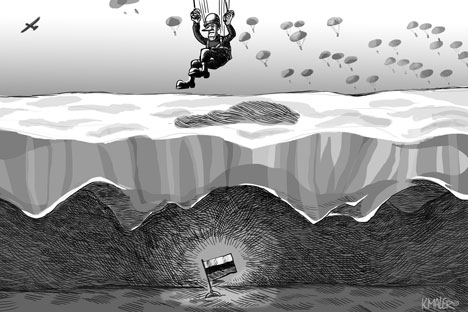
Drawing by Konstantin Maler. Click to enlarge
The Arctic has recently gained a new significance in geopolitics. The loss of Arctic ice cover has made it possible to drill for previously inaccessible oil and gas deposits and further opened up the Northern Sea Route. This increase of economic activity in the Arctic has led to an increase in competition for control of the region as well.
Speaking at an international Arctic forum in the northern Russian city of Salekhard in late 2012, President Vladimir Putin laid out Russia’s plans for the region and its importance for the country. “Russia intends to considerably expand its network of specially protected natural areas in the Arctic and to step up security there,” Putin said.
And Russia is not alone. The number of foreign military exercises in the Arctic is on the rise, with the United States, Canada and Denmark being even more active than during the Cold War. The Arctic states are rapidly modernizing their armed forces, with special consideration being given to the technology needed to operate in the Arctic.
Because the Arctic region has become a focal point for the interests of several states, Russia has recently taken decisive actions in order to solidify its claim over an area of more than 1 million square meters (10 million square feet) of sea bed stretching to the North Pole as well as upgrading its military hardware and presence in the region.
In October 2013, a force of 10 warships headed by the nuclear-powered missile cruiser Pyotr Velikiy and accompanied by nuclear icebreakers made a 2,000-mile voyage across the Barents, Kara and Laptev seas.
Speaking about the operation, Russian Deputy Defense Minister Arkady Bakhin said: “The operation was part of a big mission to master the Northern Sea Route and develop the Arctic zone.”
Russian Navy commander Viktor Chirkov added, “The expedition had accomplished its tasks of collecting data on hydrographic changes, revising sea navigation charts, collecting hydrometeorological observations and exploring the possibility of non-ice-breaking ships sailing in high latitudes.”
However, the destination of the expedition was the New Siberian Islands in the estuary of the Lena River, where they delivered hardware, fuel and housing modules to Kotelny Island as part of an effort to revive the Soviet-era air base there.
The plan is to upgrade the base to make it possible to use transport aircraft there year round, regardless of weather conditions. Answering questions about the base, Defense Minister Sergei Shoigu said: “The airfield was important as a support link in the development of transport infrastructure and would, of course, also be used as a base for Arctic expeditions and for scientific research.”
The base on Kotelny Island is only one of several being revived to protect Russian interests in the region.
Russia building its military presence in the Arctic
Rostec helping to de-mine the shelf Rostec helping to de-mine the shelf
On the Franz Josef Land archipelago, the airstrip at the Rogachevo airfield has undergone refurbishment. The airfield will house interceptor aircraft to ensure missile defense and protect Russia’s borders from an air attack from the north.
It is possible that the world’s northernmost airfield, on Graham Bell Island, which forms part of the Franz Josef Land archipelago, may be restored in the next several years.
Russia is also expanding its Arctic naval capacity. New warships capable of operating in the Arctic zone are currently under development and a new class of nuclear submarines is also in production. The first of these submarines was delivered in January 2013 and eight more are expected by 2020.
Russia’s state policy in the Arctic to 2020 and beyond envisages a strengthening of the coast guard and border control functions. To this end, Russian special-purpose military units have performed a number of operations on the Kola Peninsula, paying particular attention to practicing combat actions beyond the Polar Circle. Over the next several years, Russia may deploy two brigades in the Arctic to protect its military facilities and the infrastructure of the Northern Sea Route.
The Russian section of the Arctic is under constant foreign watch: NATO aircraft, ships and submarines as well as representatives of various research bodies and N.G.O.s are actively exploring the region.
The situation is being further complicated by the lack of effective international security regimes in the Arctic and a growing number of countries outside the region hoping to work on joint projects in the Arctic with one of the countries bordering the region.
Former Norwegian Prime Minister Jens Stoltenberg, who on Oct. 1, 2014, will assume the post of NATO secretary general, has called for strengthening multilateral military cooperation in the Arctic between Norway, Sweden, Denmark and Iceland. Stoltenberg considers it necessary by 2020 to form a joint rapid-reaction naval force, a fleet of icebreakers, amphibious units, a civil defense force, cyber security units and a satellite fleet.
The Arctic Council, a high-level intergovernmental body made up of Arctic states and observers, is supposed to address issues related to the Arctic region. However, Russia has few friends on the Council, whose other permanent members are Canada, Denmark, Finland, Iceland, Norway, Sweden and the United States.
Given the recent developments in Ukraine and tensions in Russia’s relations with the West, relations are unlikely to improve. At the current phase, a natural choice for Moscow is to strengthen the security of the Arctic region in order to retain its economic and strategic positions, at the same time developing mutually beneficial options for cooperation with foreign partners, primarily from among influential states outside the Arctic region.
Andrey Gubin is the head of research programs at the Asia-Pacific Center of the Russian Institute for Strategic Studies.
All rights reserved by Rossiyskaya Gazeta.
Subscribe
to our newsletter!
Get the week's best stories straight to your inbox